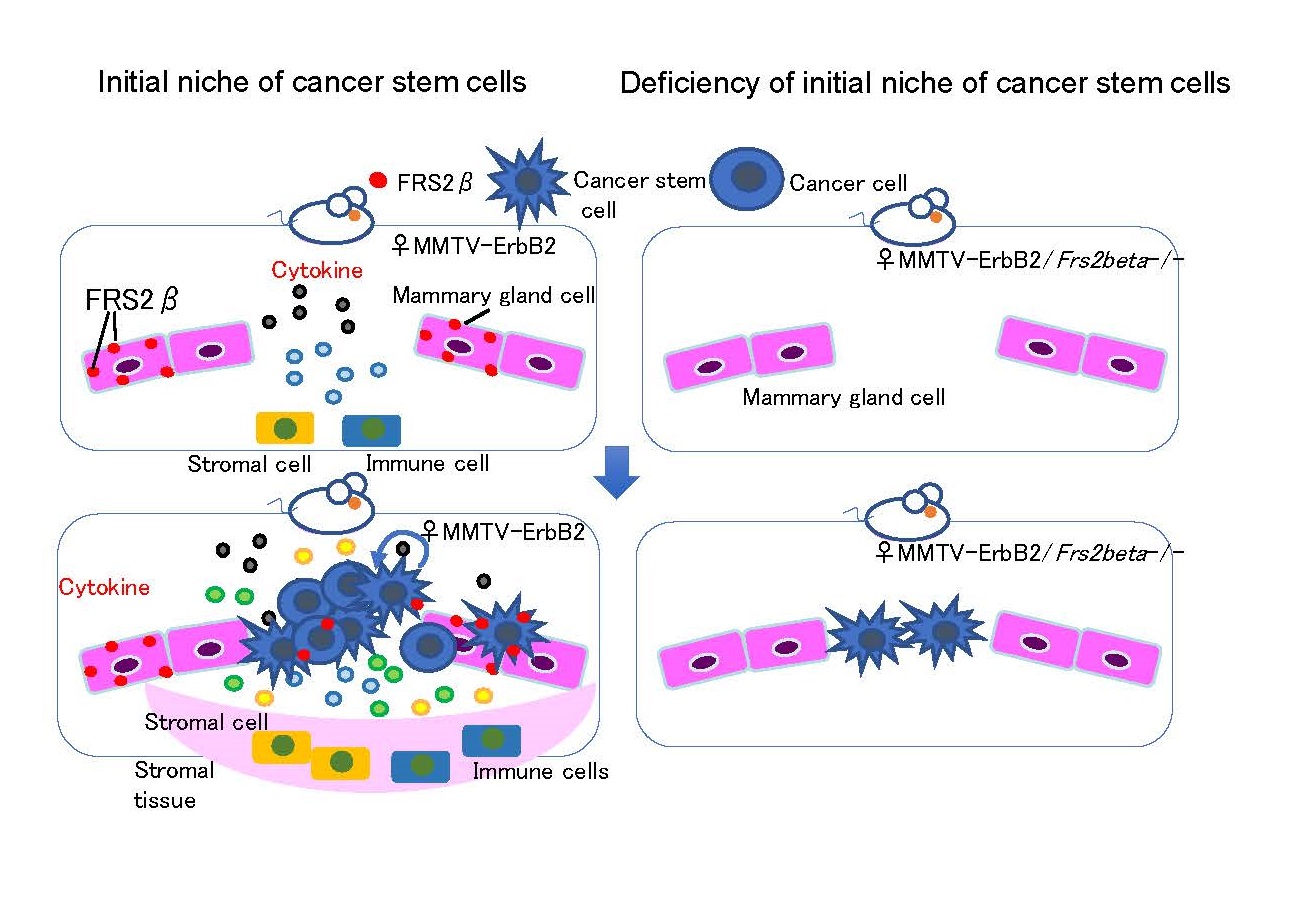Abstract: We have clarified at the molecular level the mechanism by which a microenvironment, a so-called niche that surrounds cancer cells, is formed in which stromal cells and immune cells are attracted at an initiation stage of breast cancer onset. A molecule called FRS2β is found to be critical for creating this microenvironment. The present finding is expected to be beneficial in prevention, diagnosis and treatment of cancers at the initiation stage.
[Background]
Cancer onset prevention is considered to be the most important and cost-effective long-term measure for cancer prevention. However, since the molecular mechanisms by which premalignant lesions and very early cancers begin to proliferate remains unknown in many cases, preventive methods for cancer onset based on the underlying mechanisms have not yet been developed.
In recent years, it has been considered that cancer cells having the properties of stem cells, so-called cancer stem cells, self-renew, proliferate and differentiate into all the cancer cells in tumor tissues. The development and proliferation of cancer stem cells is thought to be key to the onset of carcinogenesis. Whereas cancer stem cells are known to be affected by cytokines produced from the microenvironment formed by surrounding stromal cells and immune cells, the details of these phenomena were unclear.
[Results]
The present study was performed by a research team led by Prof. Gotoh of Kanazawa University together with scientists from Tokyo Medical University, the University of Tokyo, National Cancer Center Japan, Kyushu University, Keio University and so on. While investigating details of the microenvironment surrounding breast cancer cells, the team found that the intracellular signaling molecule FRS2β*1) is expressed in a very small subset of epithelial cells in the mammary gland.
The team went on to investigate the mammary microenvironment at the initiation stage of breast cancer carcinogenesis using MMTV-ErbB2, a model mouse that spontaneously develops breast cancer, by overexpression of cell membrane receptor tyrosine kinase HER2/ErbB2 specifically in the mammary gland. As a result, it was found that FRS2β strongly activates the inflammation master regulator transcription factor NF-κB on intracellular endosomes. It was revealed that NF-κB activated by FRS2β helps produce inflammatory cytokines and that when these inflammatory cytokines are released from the cells, stromal cells and immune cells are attracted. Upon transplantation of breast cancer stem cells into the mammary gland in this state, a large tumor mass was formed within a month. In contrast, with the FRS2β-deficient mammary gland, transplantation of breast cancer stem cells did not induce tumorigenesis (see the Figure). From this, it was found that FRS2β must activate NF-κB in cells of the mammary gland to create an initial microenvironment in order for cancer stem cells to initiate proliferation. From these results, it was clarified that the mammary gland microenvironment created by FRS2β is extremely important for the onset of breast cancer carcinogenesis.
[Future prospects]
At present, early lesions of breast cancer, Ductal carcinoma in situ (DCIS)*2), can be found by mammography. However, since one cannot tell whether the cancer cells in DCIS will subsequently proliferate and become malignant invasive cancer, the only option is surgery, which is a highly invasive treatment method, causing a problem in clinical practice. By knowing the potency of FRS2β–NF-κB axis activity in the microenvironment surrounding DCIS, it may be possible to determine the need for surgery.
It is thought that further development of the present study will enable treatments that target the mammary microenvironment that is created before breast cancer onset. Consequently, prevention of breast cancer onset and early treatment could be realized and lives could be saved.

Figure. Microenvironment at the initiation stage of breast cancer carcinogenesis generated by FRS2β.
Cancer stem cells emerging in the initial microenvironment of the mammary gland of the breast cancer mouse model MMTV-ErbB2 proliferate to form a tumor mass (left). On the other hand, MMTV-ErbB2/Frs2β -/- mammary glands lacking FRS2β do not form such an initial microenvironment and even when cancer stem cells emerge, they do not proliferate.
[Glossary]
*1) FRS2β
A membrane-bound intracellular adapter protein molecule. It was known that this protein binds to the receptor tyrosine kinase HER2/ErbB2 and suppresses the intracellular serine/threonine kinase ERK, but most of its functions were unknown.
*2) Ductal carcinoma in situ (DCIS)
The earliest lesion of breast cancer. This is a lesion in which cancer cells are localized in the milk duct without destroying and invading the basement membrane outside the mammary gland cells that surround the duct.
[Funder]
Practical Research for Innovative Cancer Control (2016-2018) and Project for Cancer Research and Therapeutic Evolution (P-CREATE) (2018-2019, 2021-2022) by AMED, the Ministry of Education, Culture, Sports, Science, and Technology KAKENHI Grants, etc.
[Article]
Title: The membrane-linked adaptor FRS2b fashions a cytokine-rich inflammatory microenvironment that promotes breast cancer carcinogenesis
Journal: Proceedings of National Academy of Sciences, USA (2021)
Authors: Takeuchi Y., Kimura N., Murayama T., Machida Y., Iejima D., Nishimura T., Terashima M., Wang Y., Li M., Sakamoto R., Yamamoto M., Itano N., Inoue Y., Ito M., Yoshida N., Inoue J.-I., Akashi K., Saya H., Fujita K., Kuroda M., Kitabayashi I., Voon D., Suzuki T., Tojo A., and Gotoh N.
DOI: 10.1073/pnas.2103658118



 PAGE TOP
PAGE TOP